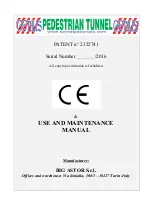
Instruction Manual IM‐186
CUSTOMER'S INFORMATION BOX
CONTENTS ARE INDEPENDENT OF RIVERHAWK DOCUMENT CONTROL
215 Clinton Road
New Hartford, NY 13413
Tel: +1 315 768 4855
Fax: +1 315 768 4941
Email: [email protected]
REV
373A4016
GE DRAWING NUMBER
Revision E
Page 4 of 23
CAUTION
DO NOT EXCEED THE MAXIMUM PRESSURE VIBROSCRIBED ON THE PULLER BODY. Excessive
pressure can damage the stud and puller screw
Note: Do not over extend the stud. Over extension can cause the piston to loose its seal and
leak oil.
Note:
Before threading the puller screw into the stud, carefully check the cleanliness of both
the stud's and the puller screw's conical threads. Apply a light coat of clean turbine oil or a
spray lubricant to the puller screw. Do not use “Never Seize” on the conical threads. This
procedure will ease assembly and assure positive mating of the threads before tightening.
2.0 Scope
This document describes the procedure to be used to install studs and nuts supplied by
Riverhawk Company in the flanges at the turbine/coupling and coupling/generator connections.
This hardware is depicted on the following drawings these drawings as well as the tooling
drawings form a part of this manual.
HF‐1554
3.0 Quick Checklist
The following checklist is intended as a summary of the steps needed to use the Riverhawk‐
supplied equipment. New personnel or those experienced personnel who have not used the
Riverhawk equipment recently are encouraged to read the entire manual.
EQUIPMENT INSPECTION
□
Check oil level in hydraulic pump.
□
Check air pressure at 80 psi [5.5 bar] minimum. (For air‐driven pumps)
□
Check hydraulic hose for damage.
□
Test pump.





































